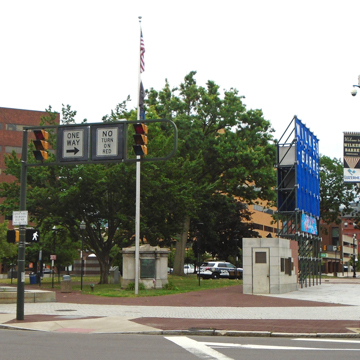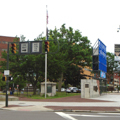At various times, Public Square has contained a palisade fort, market house, academy, Wilkes-Barre's first church, and three successive courthouses (1786, 1801, and 1856). The last of these, an animated Rundbogenstil design by Joseph C. Wells of New York City, vanished under the influence of the City Beautiful movement at the start of the twentieth century when a new courthouse was built beside the river and the city's Parks Commission took control of the venerable space. The square's present incarnation is the result of a face-lift after the 1972 flood. Bohlin and Powell's witty, humanist design was intended to create an activity-centered space that could accommodate a weekly farmers’ market, musical performances, and festivals, while simultaneously incorporating the mature trees and monuments of the preflood square. Details are infused with a gentle humor; hundreds of petroglyphs, depicting everything from themes in local history to architectural tropes, are etched into the granite pavers, and a “flood beast” rises from the park floor. The unifying element was the canopy designed by Peter Bohlin—a vast structure of steel pipes supporting a plexiglass shed roof that was to shelter pedestrians as they traversed the sidewalk between the three department stores then anchoring downtown retailing. This modernist version of an Italian arcade, built in 1978, was demolished in 2005. Even in its neglected state, Public Square remains Wilkes-Barre's focal point.
The primary casualty of those urban renewal and postflood efforts was Wilkes-Barre's Victorian downtown. Today Public Square and the first block of S. Main Street are lined with undistinguished modern office buildings and commercial structures, whose primary virtue, from an architectural standpoint, is that they incorporate retail into their ground floors. The scenography of the New Urbanist approach is represented by University Corners (2006, Cooper Carry; S. Main and E. Northampton streets), a cinemaanchored mixed-use infill project incorporating four surviving Main Street facades into its re-creation of a vanished streetscape.





